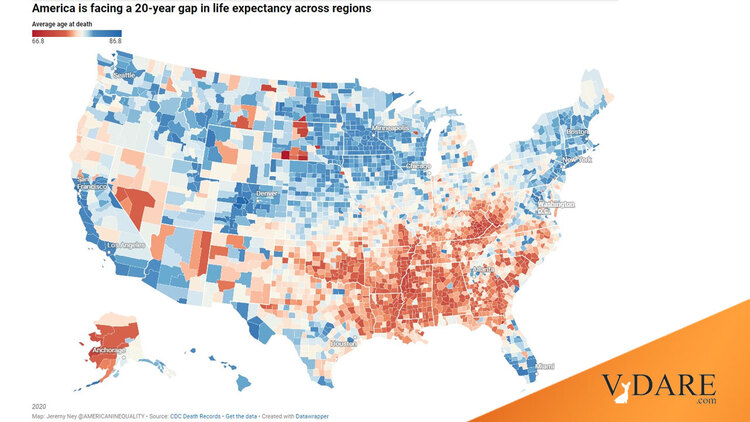


By Steve Sailer
04/07/2023

Three decades ago, Senator Daniel Patrick Moynihan (D-NY) sobered up enough to make his final contribution to American social science, Moynihan’s Law of Proximity to the Canadian Border: school test scores went up the closer a state was to the Canadian border.
In this map of average age of death, we can see a fascinating addendum: life expectancy goes up close to the Mexican border. This is because Mexicans are remarkably long-lived for their socio-economic status. Wikipedia has a long article reviewing the theories attempting to explain the Hispanic Life Expectancy Paradox.
As a minor point, I’d add that Latino women tend to have very low rates of behaving in macho knuckleheaded ways, like speeding while drunk. I suspect it’s due to Latin culture being highly encouraging of sex-stereotyped behavior: ladies should act lady-like, which leads to fewer female Deaths of Exuberance than in other cultures.
One thing to keep in mind about these county choropleth maps is that they tend to be dominated visually by wide-open spaces where few people live. For instance, the West Side of Chicago has low life expectancy, but the West Side denizens make up only a fraction of the 6 million people of Cook County, some of whom, such as North Shore suburbanites, have very long life expectancies.
So, this kind of map tends to be visually dominated by low to moderate density counties, such as the Black Belt near the Mississippi Delta around Memphis, the coal-mining belt in Kentucky and West Virginia, and various Indian reservations. You can pick out a few urban counties like Wayne, Michigan (home to Detroit), but mostly the big cities need a magnifying glance to make out and are still confounded with their suburbs.
In general, life expectancy is pretty ethnic: Asians live the longest, or perhaps Jews; Hispanics live remarkably long; as do Germans and Swedes and WASP Yankees. Shorter-lived ethnicities include American Indians, blacks, and Scots-Irish WASPs.